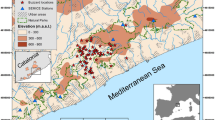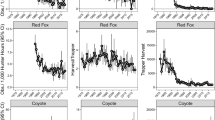Abstract
Different prey species can vary in their significance to a particular predator. In the simplest case, the total available density or biomass of a guild of several prey species might be most relevant to the predator, but behavioural and ecological traits of different prey species can alter the picture. We studied the population dynamics of a predator–prey setting in Finland by fitting first-order log-linear vector autoregressive models to long-term count data from active breeding sites of the northern goshawk (Accipiter gentilis; 1986–2009), and to three of its main prey species (1983–2010): hazel grouse (Bonasa bonasia), black grouse (Tetrao tetrix) and capercaillie (T. urogallus), which belong to the same forest grouse guild and show synchronous fluctuations. Our focus was on modelling the relative significance of prey species and estimating the tightness of predator–prey coupling in order to explain the observed population dynamics, simultaneously accounting for effects of density dependence, winter severity and spatial correlation. We established nine competing candidate models, where different combinations of grouse species affect goshawk dynamics with lags of 1–3 years. Effects of goshawk on grouse were investigated using one model for each grouse species. The most parsimonious model for goshawk indicated separate density effects of hazel grouse and black grouse, and different effects with lags of 1 and 3 years. Capercaillie showed no effects on goshawk populations, while the effect of goshawk on grouse was clearly negative only in capercaillie. Winter severity had significant adverse effects on goshawk and hazel grouse populations. In combination, large-scale goshawk–grouse population dynamics are coupled, but there are no clear mutual effects for any of the individual guild members. In a broader context, our study suggests that pooling data on closely related, synchronously fluctuating prey species can result in the loss of relevant information, rather than increased model parsimony.






Similar content being viewed by others
References
Angelstam P (1984) Sexual and seasonal differences in mortality of the black grouse Tetrao tetrix in boreal Sweden. Ornis Scand 15:123–134
Angelstam P, Lindström E, Widén P (1984) Role of predation in short-term population fluctuations of some birds and mammals in Fennoscandia. Oecologia 62:199–208
Burnham KP, Anderson DR (1998) Model selection and inference: a practical information-theoretic approach. Springer, New York
Byholm P (2005) Site-specific variation in partial brood-loss in northern goshawks. Ann Zool Fenn 42:81–90
Byholm P, Saurola L, Lindén H, Wikman M (2003) Causes of dispersal in northern goshawks (Accipiter gentilis) in Finland. Auk 120:706–716
Byholm P, Nikula A, Kentta J, Taivalmäki J-P (2007) Interactions between habitat heterogeneity and food affect reproductive output in a top-predator. J Anim Ecol 76:392–401
Cox DR, Snell EJ (1989) The analysis of binary data, 2nd edn. Chapman and Hall, London
Erlinge S (1987) Predation and noncyclicity in a microtine population in southern Sweden. Oikos 50:347–352
Errington PL (1956) Factors limiting higher vertebrate populations. Science 124:304–307
Hairston NG, Smith FE, Slobodkin LB (1960) Community structure, population control, and competition. Am Nat 94:421–425
Hanski I, Hansson L, Henttonen H (1991) Specialist predators, generalist predators, and the microtine rodent cycle. J Anim Ecol 60:353–367
Hanski I, Henttonen H, Korpimäki E, Oksanen L (2001) Small rodent dynamics and predation. Ecology 82:1505–1520
Helle P, Kurki S, Lindén H (1999) Change in the sex ratio of Finnish capercaillie Tetrao urogallus population. Wildl Biol 5:25–31
Honkala J, Björklund H, Saurola P (2010) Petolintuvuosi 2009—monien ennätysten vuosi (English summary: breeding and population trends of common raptors and owls in Finland in 2009). Linnut vuosikirja 2009:78–89
Jenkins D, Watson A, Miller GR (1967) Population fluctuations in the red grouse Lagopus lagopus scoticus. J Anim Ecol 36:97–122
Jylhä K, Fronzek S, Tuomenvirta H, Carter TR, Ruosteenoja K (2008) Changes in frost, snow and Baltic sea ice by the end of the twenty-first century based on climate model projections for Europe. Clim Change 86:441–462
Kalliosaari S, Seinä A (1987) Ice winters 1981–1985 along the Finnish coast. Finn Mar Res 254:5–63
Kenward RE, Marcström V, Karlbom M (1999) Demographic estimates from radio-tagging: models of age-specific survival and breeding in the goshawk. J Anim Ecol 68:1020–1033
Korpimäki E, Norrdahl K (1991) Numerical and functional responses of kestrels, short-eared owls, and long-eared owls to vole densities. Ecology 72:814–826
Korpimäki E, Brown P, Jacob J, Pech RP (2004) The puzzles of population cycles and outbreaks of small mammals solved? Bioscience 54:1071–1079
Krebs C, Boonstra R, Boutin S, Sinclair ARE (2001) What drives the 10-year cycles of snowshoe hares? Bioscience 51:25–35
Kruger O (2005) Age at first breeding and fitness in goshawk Accipiter gentilis. J Anim Ecol 74:266–273
Lindén H (1984) Annual patterns in the ecological energetics of the capercaillie, Tetrao urogallus, in captivity. Finn Game Res 42:19–27
Lindén H, Rajala P (1981) Fluctuations and long-term trends in the relative densities of tetraonid populations in Finland, 1964–77. Finn Game Res 39:13–34
Lindén H, Wikman M (1980) Brood size of the goshawk in relation to tetraonid densities (in Finnish with English summary). Suomen Riista 27:63–69
Lindén H, Wikman M (1983) Goshawk predation on tetraonids: availability of prey and diet of the predator in the breeding season. J Anim Ecol 52:953–968
Lindén H, Wikman M, Helle E (1989) Tetraonid populations in Finland in 1988: a comparison between the route censuses and the wildlife triangles (in Finnish with English summary). Suomen Riista 35:32–45
Lindén H, Helle E, Helle P, Wikman M (1996) Wildlife triangle scheme in Finland. methods and aims for monitoring wildlife populations. Finn Game Res 49:4–11
Lindström ER, Andrén H, Angelstam P, Cederlund G, Hörnfeldt B, Jäderberg L, Lemnell P-A, Martinsson B, Sköld K, Swenson JE (1994) Disease reveals the predator: sarcoptic mange, red fox predation, and prey populations. Ecology 75:1042–1049
Linkola P (1957) Kanahaukkakannan romahdus vuonna 1956 (in Finnish). Luonnon tutkija 61:49–58
Marjakangas A (1990) A suggested antipredator function for snow-roosting behaviour in the black grouse Tetrao tetrix. Ornis Scand 21:77–78
Oksanen L, Oksanen T (2000) The logic and realism of the hypothesis of the exploitation systems. Am Nat 155:703–723
Rajala P (1974) The structure and reproduction of Finnish populations of capercaillie, Tetrao urogallus, and black grouse, Lyrurus tetrix, on the basis of late summer census data. Finn Game Res 35:1–51
Royama T (1992) Analytical population dynamics (Population and Community Biology series 10). Chapman and Hall, London
Seinä A, Kalliosaari S (1991) Ice winters 1986–1990 along the Finnish coast. Finn Mar Res 259:3–61
Seinä A, Grönvall H, Kalliosaari S, Vainio J (1996) Ice seasons 1991–1995 along the Finnish coast. Finn Inst Mar Res 27:3–77
Seinä A, Grönvall H, Kalliosaari S, Vainio J (2001) Ice seasons 1996–2000 in Finnish sea areas. Finn Inst Mar Res 43:3–98
Seinä A, Eriksson P, Kalliosaari S, Vainio J (2006) Ice seasons 2001–2005 in Finnish sea areas. Finn Inst Mar Res 57:1–94
Selås V, Kålås JA (2007) Territory occupancy rate of goshawk and gyrfalcon: no evidence of delayed numerical response to grouse numbers. Oecologia 153:555–561
Selås V, Sonerud GA, Framstad E, Kålås JA, Kobro S, Pedersen HB, Spidso TK, Wiig O (2011) Climate change in Norway: warm summers limit grouse reproduction. Popul Ecol 53:361–371
Siivonen L (1957) The problem of the short-term fluctuations in numbers of tetraonids in Europe. Riistatieteellisiä julkaisuja/Pap Game Res 19:1–44
Sirkiä S, Lindén A, Helle P, Nikula A, Knape J, Lindén H (2010) Are the declining trends in forest grouse populations due to changes in the forest age structure? A case study of Capercaillie in Finland. Biol Conserv 143:1540–1548
Slagsvold T, Sonerud GA, Gronlien HE, Stige LC (2010) Prey handling in raptors in relation to their morphology and feeding niches. J Avian Biol 41:488–497
Spidso TK, Hjeljord O, Dokk JG (1997) Seasonal mortality of black grouse Tetrao tetrix during a year with little snow. Wildl Biol 3:205–209
Sulkava S (1964) Zur nahrungsbiologie des habichts, Accipiter gentilis (L.) (in German). Aquilo Ser Zool 3:1–103
Sulkava S, Linkola P, Lokki H (2006) Diet of the Goshawk during breeding season in Häme (in Finnish with English summary). Suomen Riista 52:85–96
Swenson JE (1993) The importance of alder to hazel grouse in Fennoscandian boreal forest: evidence from four levels of scale. Ecography 16:37–46
Tornberg R (1997) Prey selection of the goshawk Accipiter gentilis during the breeding season: the role of prey profitability and vulnerability. Ornis Fenn 74:15–28
Tornberg R (2001) Pattern of goshawk Accipiter gentilis predation on four forest grouse species in northern Finland. Wildl Biol 7:245–256
Tornberg R, Colpaert A (2001) Survival, ranging, habitat choice and diet of the northern goshawk Accipiter gentilis during winter in northern Finland. Ibis 143:41–50
Tornberg R, Sulkava S (1991) The effect of changing tetraonid populations on the nutrition and breeding success of the goshawk (Accipiter gentilis L.) in northern Finland. Aquilo Ser Zool 28:23–33
Tornberg R, Virtanen V (2001) When and why do goshawks die? (in Finnish with English summary). Linnut 32:10–13
Tornberg R, Korpimäki E, Byholm P (2006) Ecology of the northern goshawk in Fennoscandia. Stud Avian Biol 31:141–157
Turchin P (2003) Complex population dynamics: a theoretical empirical synthesis (Monographs in Population Biology). Princeton University Press, Princeton
Wegge P, Rolstad J (2011) Clear-cutting forestry and Eurasian boreal forest grouse: long-term monitoring of sympatric capercaillie Tetrao urogallus and black grouse T. tetrix reveals unexpected effects on their population performances. For Ecol Manag 261:1520–1529
Wegge P, Rolstad I, Gjerde I, Storaas S (1990) Does forest fragmentation increase the mortality rate of capercaillie? In: Myrberget S (ed) Transactions of the XIX IUGB congress, Trondheim. Norwegian Institute for Nature Research, Trondheim, pp 448–453
Widén P (1987) Goshawk predation during winter, spring and summer in a boreal forest area of central Sweden. Holarc Ecol 10:104–109
Wiens JD, Reynolds R (2005) Is fledging success a reliable index of fitness in northern goshawks? J Raptor Res 39:210–221
Zimmerman GS, Horton RR, Dessecker DR, Gutiérrez RJ (2008) New insight into old hypotheses: ruffed grouse population cycles. Wilson J Ornithol 120:239–247
Acknowledgments
We are grateful to all voluntary ringers and hunters who helped to collect goshawk and grouse data, respectively. We thank Geir A. Sonerud and an anonymous reviewer for their thorough comments and suggestions of how to improve the analysis and manuscript text. The work was funded by the Academy of Finland (AL; grant ref. 135682).
Author information
Authors and Affiliations
Corresponding author
Additional information
Communicated by Douglas Robinson.
Esa Ranta: deceased in August 2008.
Electronic supplementary material
Below is the link to the electronic supplementary material.
Rights and permissions
About this article
Cite this article
Tornberg, R., Lindén, A., Byholm, P. et al. Coupling in goshawk and grouse population dynamics in Finland. Oecologia 171, 863–872 (2013). https://doi.org/10.1007/s00442-012-2448-z
Received:
Accepted:
Published:
Issue Date:
DOI: https://doi.org/10.1007/s00442-012-2448-z




